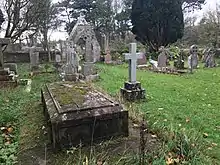George Boyle, 6th Earl of Glasgow
George Frederick Boyle, 6th Earl of Glasgow DL (9 October 1825 – 23 April 1890) was a Scottish nobleman.
The Earl of Glasgow | |
|---|---|
| 6th Earl of Glasgow | |
 Lord Glasgow's raised tomb within the grounds of the Cathedral of the Isle in Millport | |
| Predecessor | James Carr-Boyle, 5th Earl of Glasgow |
| Successor | David Boyle, 7th Earl of Glasgow |
| Born | George Frederick Boyle 9 October 1825 |
| Died | 23 April 1890 (aged 64) |
| Spouse(s) | The Hon. Montague Abercromby
(m. 1856) |
Issue
| |
| Parents | George Boyle, 4th Earl of Glasgow Julia Sinclair |
He was the son of George Boyle, 4th Earl of Glasgow and Julia Sinclair, daughter of Sir John Sinclair, 1st Baronet.
In February 1847, Boyle traveled with Frederick Hamilton-Temple-Blackwood, 1st Marquess of Dufferin and Ava to Skibbereen in County Cork to try and aid victims of the Irish Famine. Lord Dufferin left a memoir of their journey entitled Narrative of a Journey from Oxford to Skibbereen during the Year of the Irish Famine published in 1847.
He married Hon. Montague Abercromby (1835–1931), daughter of George Abercromby, 3rd Baron Abercromby and Louisa Penuel Forbes, on 29 April 1856. They had two daughters
- Lady Gertrude Julia Georgina Boyle (15 November 1861 – 12 December 1950); married Thomas Cochrane, 1st Baron Cochrane of Cults, had eight children.
- Lady Muriel Louisa Diana Boyle (18 November 1872 – 3 April 1915); died unmarried
He was elected at a by-election in February 1865 as the Member of Parliament (MP) for Buteshire, but held the seat only until the general election in July 1865.[1]
He succeeded to his half brother's titles on 11 March 1869.
He held the offices of Deputy Lieutenant of Fife and Renfrewshire. He held the office of Lord Clerk Register of Scotland from 1879 until his death.
He died at age 64, without male issue. On his death, the UK barony of Ross of Hawkhead became extinct.
Religion
Boyle was an Episcopalian and was a long time associate of Bishop Alexander Penrose Forbes and a supporter of his views. Correspondence between the two men is held by the University of Dundee's archives.[2] In 1848 the Boyle founded a choir school attached to the Church of St. Andrews, Millport. He followed this up in 1849 by founding and endowing the Episcopal College and Collegiate Church of the Holy Spirit, Cumbrae. The college was completed in 1851 to plans by William Butterfield and was later affiliated to the University of Durham as Cumbrae Theological College. While the Collegiate Church was elevated to the status of Cathedral of Argyll and the Isles in 1879, the college ultimately closed in 1888.[3]
References
- Leigh Rayment's Historical List of MPs – Constituencies beginning with "B" (part 6)
- "BrMS 1Diocese of Brechin: Correspondence of Alexander Penrose Forbes, Bishop of Brechin and George Frederick Boyle". Archive Services Online Catalogue. University of Dundee. Archived from the original on 1 October 2015. Retrieved 30 September 2015.
- "MS 54 College and Collegiate Church of The Holy Spirit, Isle Of Cumbrae". Archive Services Online Catalogue. University of Dundee. Archived from the original on 1 October 2015. Retrieved 30 September 2015.
- Secondary sources
External links
- Hansard 1803–2005: contributions in Parliament by the Earl of Glasgow
- thepeerage.com George Frederick Boyle, 6th Earl of Glasgow
| Parliament of the United Kingdom | ||
|---|---|---|
| Preceded by David Mure |
Member of Parliament for Buteshire February 1865 – July 1865 |
Succeeded by James Lamont |
| Political offices | ||
| Preceded by Sir William Gibson Craig |
Lord Clerk Register 1879–1890 |
Succeeded by The Duke of Montrose |
| Peerage of Scotland | ||
| Preceded by James Carr-Boyle |
Earl of Glasgow 1869–1890 |
Succeeded by David Boyle |
| Peerage of the United Kingdom | ||
| Preceded by James Carr-Boyle |
Baron Ross 1869–1890 |
Extinct |